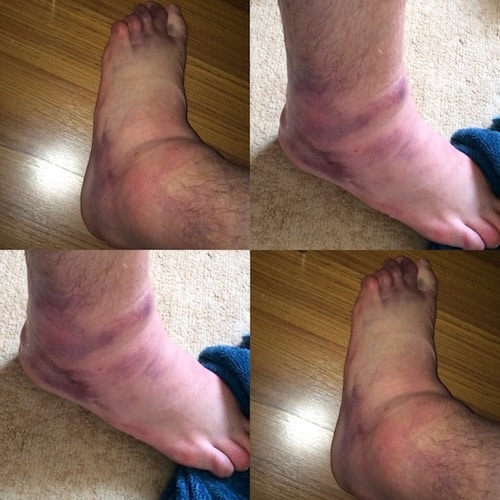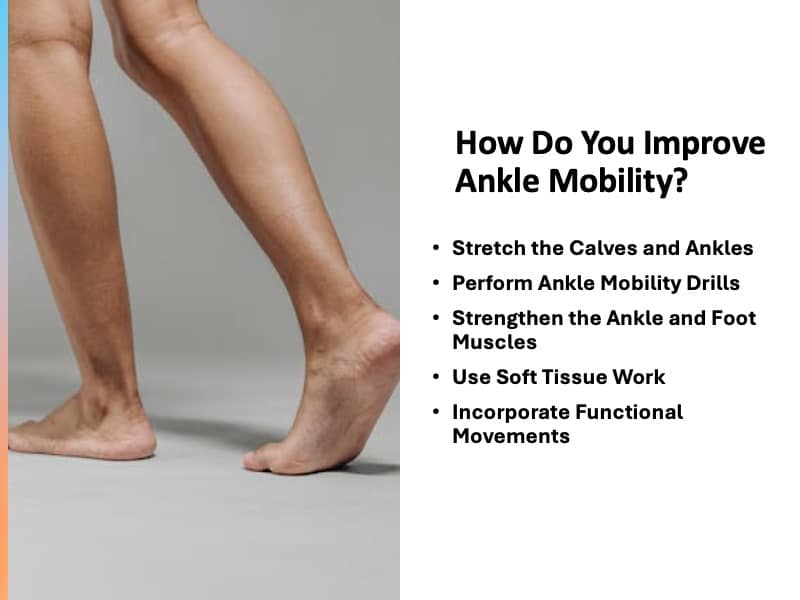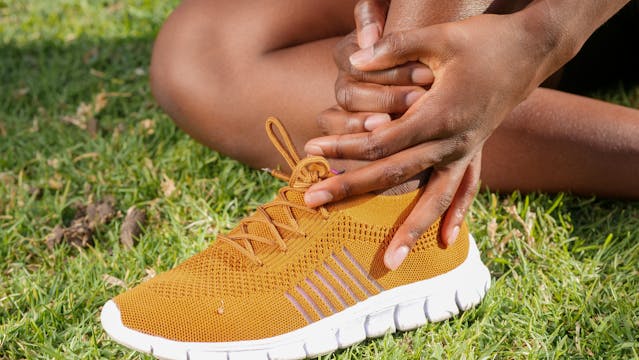How to Improve Ankle Mobility: Pro Athlete Adam Kemp Tells
Ankle mobility plays a vital role in athletic performance and injury prevention.
Throughout my professional basketball career, I have experienced the consequences of inadequate ankle mobility firsthand, spraining both of my ankles several times and suffering severe ankle injuries during my second professional season with BC Astana in Astana, Kazakhstan, and again in my seventh professional season in Lublin, Poland.
So you know I’m not lying, here are some images from my ankle injury from 2015 in Astana, when I tore the ligaments on both sides of my ankle, fractured a bone, and received a bone bruise.

Along with the other well-known benefits of improving ankle mobility and health for a variety of populations, these injuries have taught me the critical importance of prioritizing ankle health.
By focusing on developing ankle mobility, strength, and stability, I have been able to regain control over my ankle joints and build more resilient ankles.
This journey has not only improved my performance on the court but also significantly improved my confidence in avoiding future injuries.
If you want to improve your ankle mobility, read the rest of this article!
What is Ankle Mobility?
Ankle mobility refers to the ability of the ankle joint to move freely and efficiently through its full range of motion, particularly in dorsiflexion (bringing the toes toward the shin) and plantarflexion (pointing the toes downward).
Good ankle mobility supports smoother, more natural movement patterns that are essential for athletic performance and daily activities. It also improves proprioception, which is the body’s ability to sense its position and movement in space, helping prevent slips, missteps, and rolled ankles (Hoch et al., 2012; McKeon & Hertel, 2008).
When ankle mobility is limited, the body compensates with poor mechanics, often placing additional stress on the knees, hips, and lower back.
Over time, this can create a chain reaction of biomechanical issues, leading to chronic injuries, reduced athletic power, and diminished movement efficiency.
Whether recovering from an injury or seeking to optimize athletic potential, improving ankle mobility builds a foundation for better movement quality, more efficient force production, and long-term joint health.
Why is Ankle Mobility Important?
Ankle mobility plays a critical role in athletic performance, injury prevention, and maintaining overall lower body function.
It allows for smoother movement, better stability, and reduces strain on surrounding joints like the knees and hips.
Following an injury, ankle mobility often deteriorates, leading to stiffness, compromised stability, and a higher risk of re-injury.
Restoring ankle mobility is essential for regaining proper movement mechanics, strengthening the supporting muscles and ligaments, and ensuring long-term joint resilience.
Better ankle mobility also promotes fluidity in athletic movements like sprinting, jumping, and quick directional changes while improving balance, coordination, and overall body alignment.
Throughout my professional basketball career, consistently working on ankle mobility has been vital for strengthening my ankles, accelerating recovery from severe injuries, and rebuilding my confidence on the court.
With dedication, anyone can experience these benefits, leading to stronger, healthier, and more resilient ankles over time.
How Do You Improve Ankle Mobility?

Improving ankle mobility requires a combination of stretching, strengthening, and movement drills to improve range of motion, stability, and control.
Consistently incorporating these exercises into your routine can lead to noticeable improvements in a few weeks.
Here is some general advice on how to improve ankle mobility, before I how you the best ankle mobility exercises:
Stretch the Calves and Ankles
Tightness in the calves and Achilles tendons often restricts dorsiflexion, which is crucial for squatting, jumping, and running efficiently.
Stretching the gastrocnemius (upper calf) and soleus (lower calf) muscles improves ankle flexibility, reduces stiffness, and helps restore full range of motion.
Key tip: Perform both straight-leg and bent-knee calf stretches to target different layers of the calf complex. Stretch each leg for at least 30 seconds, and repeat for 2–3 rounds per session.
Perform Ankle Mobility Drills
Specific ankle drills create controlled movement through the joint’s full range, helping to improve joint mechanics and fluidity.
Exercises like ankle circles, dorsiflexion wall drills, and controlled toe raises help retrain the nervous system to allow greater mobility and strength simultaneously.
Key tip: Focus on slow, deliberate motions to build neuromuscular control instead of rushing through drills.
Strengthen the Ankle and Foot Muscles
Building strength in the small stabilizing muscles of the foot and ankle is crucial for maintaining new ranges of motion and preventing instability-related injuries.
Exercises such as resistance band dorsiflexion, single-leg balance work, and towel scrunches target these often-overlooked muscles, creating a stronger and more resilient foundation.
Key tip: Incorporate balance challenges, like standing on one foot with your eyes closed, to improve stability and proprioception alongside strength gains.
Use Soft Tissue Work
Self-myofascial release techniques can help break up adhesions, release tight fascia, and improve tissue quality around the ankle and calf muscles.
- Lacrosse Ball Massage: Roll a lacrosse ball or vibrating massage ball (such as the Hyperice Hypersphere) under your foot and along your calves to break up tight tissue and stimulate blood flow.
- Foam Rolling: Foam rolling the calves and Achilles tendon helps reduce stiffness and prepares the muscles for stretching and strengthening work. Personally, I prefer the Roll Recovery R8 device because it offers greater pressure and better control for targeting the calf muscles effectively.
Key tip: Spend at least 1–2 minutes on each leg during soft tissue work, and use slower, deeper pressure for the most benefit.
Incorporate Functional Movements
Functional exercises that require full ankle dorsiflexion under load reinforce mobility gains in real-world movement patterns. Deep squats, Cossack squats, lunge variations, step-ups, and many other single-leg exercises train the ankles to move correctly under body weight or resistance.
Key tip: Prioritize keeping your heels flat during squats and lunges to encourage full ankle range of motion. Use assistance like a TRX strap or support if needed at first, then progress toward unassisted, deeper ranges as mobility improves.
How Long Does it Take to Improve Ankle Mobility?
Improving ankle mobility can take anywhere from a few weeks to several months, depending on factors like the severity of restriction, consistency of training, and individual flexibility.
- Minor stiffness or mild restrictions can improve within 2–4 weeks with daily mobility exercises.
- Moderate limitations, such as post-injury stiffness, may require 4–8 weeks of consistent work to see noticeable gains.
- Severe restrictions or long-term mobility deficits may take 3–6 months or longer, especially if rebuilding strength and stability after an injury.
Consistency is key—daily or near-daily mobility work, combined with strengthening and proper movement mechanics, leads to the best results.
The Best Ankle Mobility Exercises
Incorporating these ankle mobility exercises and their progressions into your routine can improve your ankle mobility, strength, and stability, reducing the risk of injuries and improving your overall athletic performance.
Here are some of my favorite ankle mobility exercises that target different aspects of ankle mobility and stability:
Draw the Alphabet
- Description: Drawing the alphabet with your foot improves ankle mobility and stability by engaging multiple muscles and movements.
- Benefits: Improves joint flexibility, muscle coordination, and overall ankle strength, while also improving the mobility of the standing leg and cross-body control.
- How to Perform: Stand on one leg. Using the big toe of the lifted foot as a “pen,” draw the alphabet in the air, ensuring each letter is clear and distinct. Complete the entire alphabet twice with each foot, focusing on controlled and deliberate movements. To advance this exercise, try performing it with your eyes closed to further improve proprioception and balance.
- Progression: Perform the exercise while balancing on a wobble board or Bosu ball to further challenge stability and proprioception.
Ankle Dorsiflexion Wall Stretch
- Description: This exercise stretches the ankle by dorsiflexing it against a wall, enhancing flexibility and mobility.
- Benefits: Improves ankle dorsiflexion and helps reduce stiffness in the ankle joint.
- How to Perform: Stand with your toes a few inches away from a wall. Bend your knee to touch the wall while keeping your heel on the ground. Gradually increase the distance between your toes and the wall to increase the stretch. Repeat for 3 sets of 10-15 reps on each leg.
- Progression: Increase the distance from the wall or add a small weight on the knee to intensify the stretch.
Band-Resisted Ankle Dorsiflexion
- Description: Using a resistance band to assist in dorsiflexion helps increase ankle mobility and strength.
- Benefits: Targets the muscles responsible for dorsiflexion, enhancing flexibility and strength.
- How to Perform: Secure a resistance band around a fixed object and loop it over the foot. Pull the toes towards the shin against the band’s resistance, holding for 2-3 seconds. Repeat 10-15 times on each foot, ensuring controlled and steady movements.
- Progression: Increase the resistance of the band or perform the exercise while standing on one leg to further challenge the ankle and lower leg muscles.
Heel-to-Toe Walks
- Description: Walking with a normal stride but stepping heel to toe helps improve balance and ankle strength. Aim to keep your feet in a single line and bring your knee up on each step.
- Benefits: Improves balance, ankle mobility, and coordination.
- How to Perform: Walk forward with a normal stride, ensuring each step places the heel directly in front of the opposite foot’s toes, keeping feet in one line. Bring your knee up on each step to engage the hip flexors and improve the exercise. Perform for 20-30 steps, maintaining an upright posture and controlled movements.
- Progression: Perform heel-to-toe walks while holding light dumbbells or with eyes closed to further challenge balance and coordination.
Wall Calf Stretch
- Description: Stretching the calf muscles improves flexibility and reduces tension, aiding in better ankle dorsiflexion.
- Benefits: Improves ankle dorsiflexion and overall lower leg flexibility.
- How to Perform: Stand facing a wall, place one foot back with the heel on the ground, and lean forward until a stretch is felt in the calf. Hold for 20-30 seconds, then switch legs. Repeat 2-3 times on each leg.
- Progression: Perform the calf stretch on an elevated surface, such as a step or curb, to increase the stretch intensity on the lower leg muscles.
Cossack Squat
While more advanced than basic stretches, mastering the Cossack squat offers one of the most effective ways to build functional, lasting ankle mobility for athletic performance and injury prevention.
- Description: The Cossack squat is an advanced bodyweight exercise that challenges and improves ankle dorsiflexion, hip flexibility, and full lower-body mobility through deep, controlled lateral movement.
- Benefits: Improves dynamic ankle mobility, strengthens stabilizing muscles around the ankle and foot, and improves overall balance and flexibility.
- How to Perform: Stand with feet wide apart. Shift your weight onto one leg, squatting deeply while keeping the opposite leg extended with toes pointed up. Focus on keeping the squatting foot flat to fully engage ankle dorsiflexion. Push through the heel to return to standing, then repeat on the other side.
- Progression: Start with supported Cossack squats (holding onto a band or TRX strap) to build mobility and balance. As strength and flexibility improve, work toward deeper, unassisted squats with longer holds at the bottom to further improve ankle mobility.
Best Ankle Mobility Workouts
If you want full-length ankle mobility workouts at home, I highly suggest you check out the Team Beachbody On-Demand App – Bodi.com.
I started using Bodi.com this past year and have been loving their online resources.
There are many great trainers on their website, like Amoila Caesar and Lindsay Sudell, who offer structured programs focusing on mobility, strength, and stability.

Amoila Caesar’s programs, such as his 645 workout program, blend strength training with flexibility and mobility exercises, emphasizing functional fitness.
His routines include dynamic movements and specific ankle mobility exercises, making them accessible and scalable for all fitness levels.
Lindsay Sudell’s programs are ideal for enhancing flexibility and mobility, and her detailed routines integrate static and dynamic stretches, along with mobility drills to improve joint health and range of motion.
These structured online workouts have been crucial in improving my ankle health.
Following expert trainers and the convenience of home workouts have significantly benefited my training routine and made my life much easier.
Additionally, I enjoy these workouts as these programs promote fluid movement, better balance, increased strength, aid recovery, and enhance overall performance.
Final Thoughts: Can You Improve Ankle Mobility?
Improving ankle mobility may seem challenging, especially if you’ve experienced significant injuries. like I have
However, with consistent effort and the right exercises, significant improvements can be achieved.
Incorporating exercises like drawing the alphabet with your foot, the ankle dorsiflexion wall stretch, band-resisted ankle dorsiflexion, heel-to-toe walks, and calf stretches into your routine can make a substantial difference, but there is an enormous world of ankle mobility and stability exercises that you can use.
If you have bad ankles, online resources, such as Team BeachBody’s workouts, can simplify the process.
Remember, consistency is key.
While it may take time to see significant changes, the benefits of improved ankle mobility—such as fluid movement, better balance, and increased strength—are well worth the effort.
These exercises not only aid in recovery from injuries but also enhance overall athletic performance by providing a solid foundation for all physical activities.
With dedication and the right approach, you can build healthier, more resilient ankles, reducing the risk of future injuries and ensuring better performance in your athletic endeavors!
This website does not provide medical advice. This website site does contain affiliate links, and purchases may earn a commission.
Read my Medical Disclaimer, Review Disclaimer, and Publishing Policies for more details. Use of this site indicates acceptance of these terms.



